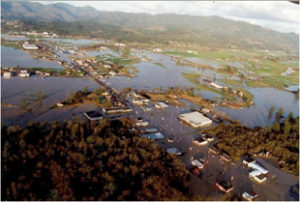At the recent National Brownfields Conference, held this year in Pittsburgh, Pennsylvania, a Phoenix Award for excellent in brownfields cleanup and restoration or redevelopment was presented to the Southern Flow Corridor project in Tillamook County, Oregon.
Five major rivers drain into Tillamook Bay. The lower valleys of the Wilson, Trask, and Tillamook rivers merge to form a broad floodplain at the head of the bay on which the City of Tillamook is located. The Wilson River flows through a steep canyon out of the mountains and does not have any significant floodplain until around six miles above the bay.
The river channel is perched, meaning it runs in a channel with natural banks that are higher than the floodplains around it. Consequently, flood flows that leave the Wilson River, especially to the much larger southern floodplain, never return to the channel but flow south to the lowest part of the valley and west to meet the Trask and Tillamook Rivers. Highway 101 crosses the Wilson River floodplain at grade and so suffers frequent deep inundation across its lowest portions between Hoquarton and Dougherty Sloughs.
Major flooding in February of 1996 caused $53 million in damages within Tillamook County, the highest per capita loss in the state’s history, and the equivalent of 148% of the county’s annual budget.
Subsequent large floods occurred in 1998 and 1999, and most recently in 2006 and 2007, causing further damage. Following the 2007 flood, Oregon Governor Ted Kulongoski designated addressing Tillamook flooding issues as an Oregon Solutions project. Under a community governance model, Oregon Solutions brought together federal, state, and local government agencies with community leaders to seek collaborative solutions.
Over the next six years, the Oregon Solutions team collaborated on the consideration of ecosystem restoration alternatives that provided flood damage reduction benefits in the upper Tillamook Bay floodplain, which included the City of Tillamook and U.S. Highway 101 business corridor.
After substantial hydraulic modeling, the team decided to pursue the project since it provided the largest benefits in flood damage reduction. The County
purchased five private properties to accomplish the 690-acre project. One of the properties was a former veneer mill site and was known to have legacy hazardous substance and petroleum product contamination at levels above ecological receptor standards. The County’s purchase of the old mill site property was identified as critical to ensure ecological health and flood reduction goals.
Tillamook County’s Southern Flow Corridor Project speaks strongly to the will, perseverance, and creativity of a rural community to build resiliency back into its environment. Borne from the critical need to mitigate flooding in the City of Tillamook, the project restored 520 acres of tidal wetlands creating one of the largest wetland restoration areas in the northwest, but also addressed the commercial, residential, and agricultural concerns and needs of the region.
The positive economic and social effects the project has on flood damage reduction cannot be overstated in a community ravaged by flooding in recent years. The successful collaboration of more than 100 federal, state, and local partners is estimated to yield substantial ecological and socio-economic benefits.
Brownfield redevelopment funding solely supported 10 acres of remediation on the 690-acre project.
“The cleanup of the old mill site and redevelopment as a recreational-use parking area and kayak launch pathway provides a significant benefit to Tillamook’s residents and tourists alike,” says Aaron Palter, Port of Tillamook Bay Project Manager. “The City is also looking into the possibility of siting its new dog park at this location, amongst other considerations, but nothing is set in stone yet,” he added.
Wildlife is benefiting too. Listed as “threatened” under the federal Endangered Species Act, Oregon coastal coho salmon populations have been severely impacted by the loss of off-channel and tidal wetland habitats. In few places is this impact more pronounced than in Oregon’s Tillamook Bay, where almost 90% of the estuary’s tidal wetlands have been lost to agricultural and urban/residential development.
The resulting lack of available tidal wetland habitats has been a primary contributor to the decline of Tillamook Bay coho, and today’s runs (just over 2,000 fish in 2012) represent a fraction of estimated historic abundance (~200,000). Likewise, the lack of available tidal wetland habitats has been identified as a key impediment to species recovery. These tidal habitat losses have impacted the Bay’s four other anadromous species, as well, particularly Chinook which use tidal wetlands extensively for rearing.
This project has produced long-term ecological benefits for salmon and socioeconomic benefits for people:
- Reduced flooding in the Highway 101 business corridor and adjacent residential/agricultural lands, including measureable reductions in flood elevation and duration;
- Improved freshwater and estuarine water quality, including reductions in temperature, dissolved oxygen, and turbidity;
- Increased habitat complexity and availability across the range of tidal wetland habitats; and
- Enhanced ecological function benefiting other aquatic, terrestrial, and avian species.
Featured photo courtesy of Oregon Solutions.
See full text of Southern Flow Corridor project’s Phoenix Award (PDF).
See Southern Flow Corridor website.


